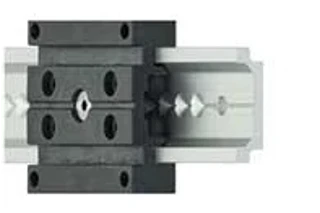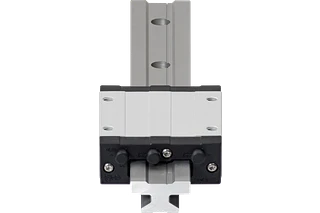Change Language :

Choosing a Linear Bearing: A Quick Reference Guide

1: igus® offers four different types of drylin® linear bearing guide systems.
Engineers often ask me how they can quickly narrow down which drylin® linear bearing product to look at first: drylin® N, drylin® T, drylin® W or drylin® R? This quick-start reference guide will set you off in the right direction before you begin perusing our catalog specifications or downloading our CAD files.
Below is a brief description of each drylin® system and their ratings (using a scale of one to five, five representing the most desirable) for the following:
- Loading
- Low profile
- Temperature resistance
- Corrosion resistance
- Price
- Environmental performance
- Adjustable clearance availability

2: drylin® W is lubrication-free and available in multiple rail configurations.
#1: DryLin® W linear guide system
Loading: 3
Low Profile: 4
Temperature resistance: 4
Corrosion resistance: 5
Price: 5
Performance in dirty environments: 4
Adjustable clearance availability: 5
The drylin® W series is most often recommended by our sales engineers when they’re assisting customers with new designs. The combination of flexibility, long life and low cost are the driving factors behind this system’s success. The rail is available as either a double-rail system, which many customers like because this eliminates the need to align rails, or as single rails for flexibility.
drylin® W (especially the WSQ square systems) are also best for applications where rail alignment is an issue, or where sheet metal, plastic surfaces or weldments are used in framing the system.
When not to use drylin® W: With loads exceeding 2,880 pounds (instead try drylin® R or T) or applications that require unsupported shafting (try drylin® R).
Insider tip: The 316SS configuration is ideal for applications where corrosion is an issue.

3: drylin® N linear bearings are ideal for low-profile applications.
#2: DryLin® N linear guide system
Loading: 1
Low profile: 5
Temperature resistance: 3
Corrosion resistance: 3
Price: 5
Performance in dirty environments: 2
Adjustable clearance availability: N/A
drylin® N features a maximum height of just under 0.5 inches, which makes it ideal for low-profile applications in conjunction with small loads. Although it’s sometimes considered a small, simple bearing, customers have had great success with drylin® N in applications ranging from high-tech storage-and-retrieval robots and laboratory devices to furniture and interior aircraft applications.
When not to use drylin® N: With any load that exceeds 880 pounds for a four-bearing system, in temperatures over 194 degrees Fahrenheit (for both of these, consider drylin® R) or in extremely dirty, dusty environments, as the guide channel can become like a trough (instead try drylin® R or W).
Insider tip: Try the pre-loaded styles, which help eliminate small clearances.

3. drylin® R linear plain bearings is capable of handling loads of more than 20,000 pounds.
#3 DryLin® R linear plain bearings
Loading: 5
Low profile: 1
Temperature resistance: 5
Corrosion resistance: 5
Price: 3
Performance in dirty environments: 5
Adjustable clearance availability: 3
drylin® R is our original linear bearing design and was first introduced as a dimensional interchange with most re-circulating ball bearing systems found on the market. One of the most impressive features of drylin® R is its extreme load capability: over 20,000 pounds on a single two-inch-inner-diameter liner.
drylin® R bearings can be used with a variety of shaft materials, including case-hardened steel, anodized aluminum and stainless steel (including 304, 316 and 440), which makes them very appealing when retrofitting machinery. Also, drylin® R bearings could not be better for the price, as they’re comprised of high-performance polymers and are able run on both aluminum and stainless shafting. Keep in mind, for high-volume applications it’s best to use just the small sleeve liner instead of an entire pillow block or additional housing. This will reduce your parts list and expenditures.
When not to use: If height is an issue (instead try drylin® W or N), or if you’re looking for a lower-cost option (consider drylin® W if a lower load rating is acceptable).
Insider tip: For optimal performance, the adjustable RJUME and OJUME metric styles can be used to manually reduce the clearance associated with sliding bearings.

drylin® T linear guide systems are dimensionally interchangeable with ball bearing profile guides.
#4 DryLin® T linear guide system
Loading: 4
Low profile: 3
Temperature resistance: 2
Corrosion resistance: 3
Price: 4
Performance in dirty environments: 3
Adjustable clearance availability: 4
drylin® T is typically used in applications requiring a dimensional interchange with ball bearing profile guides. It’s also a great option if you want to use only one rail and one or two carriages since it is rigid in the axis of travel. This factor is sometimes overlooked, but actually makes the system a great low-cost option to multiple rail systems. Another reason some of our customers use drylin® T has to do with aesthetics – this system delivers a very high-end look at a relatively low cost.
When not to use: In temperatures exceeding 194 degrees Fahrenheit (consider drylin® R or W) or when small footprints or envelopes must be kept (try drylin® N or W, assuming you need more than one carriage).
Insider tip: The version TWA-01-xx automatically adjusts to the lowest clearance possible, unlike the standard TW-01-xx series, which is designed for optional manual clearance adjustment.
Conclusion While all drylin® linear systems are corrosion-resistant, maintenance-free and deliver a long service life, we also highly recommend using our drylin® Expert System once you’ve chosen a product. Running the application through the system will provide you with loading, lifetime, and clearance results.
I hope this information will help guide you through your next design using drylin® linear bearings. Please call 1-800-521-2747 or e-mail sales@igus.com for technical assistance or to schedule an on-site meeting to discuss your application in greater detail.
Useful Links and Tools